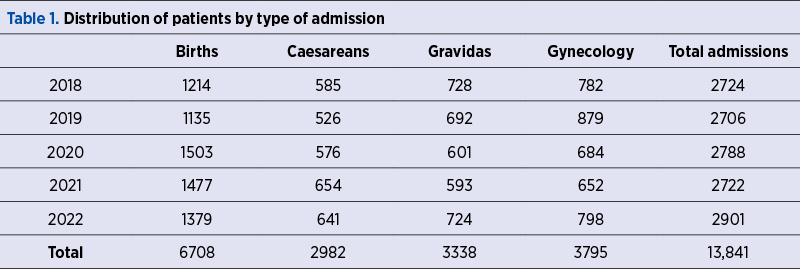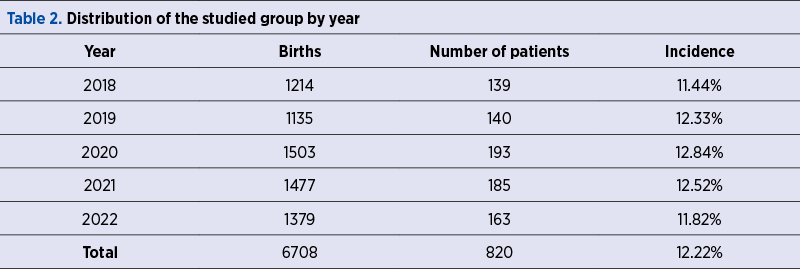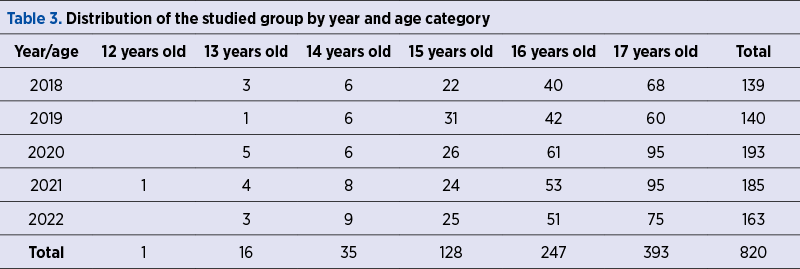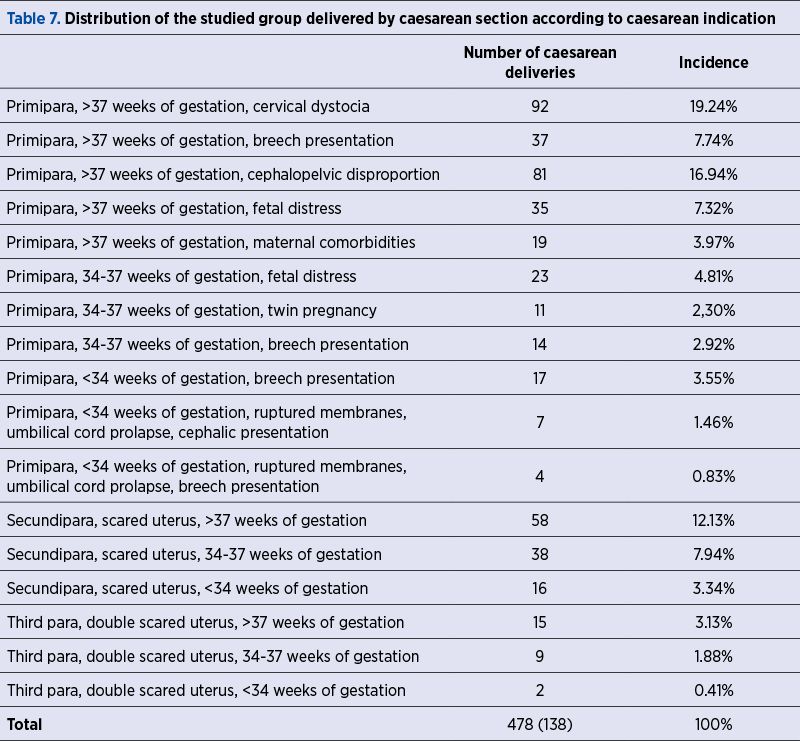Teenage pregnancy refers to pregnancy that occurs in adolescent females under the age of 18 years old, although some authors include females under the age of 20 years old. Teenage girls have a higher risk of developing complications related to pregnancy, and the rate of caesarean section can rise dramatically. Cases of teenage women with pregnancy must be approached in a multidisciplinary manner and need a closer checkup than other pregnancies. The following study was conducted in the “Sf. Ap. Andrei” County Emergency Clinical Hospital, Constanţa, over a period of five years, between 2018 and 2022, and followed the incidence, the sociocultural environment, the rate of caesarean section and the indications for surgery.
Teenage pregnancy – an unsolved problem of the 21st century. Populational register-based study in the County Clinical Hospital Constanţa
Sarcina la adolescenţă – o problemă nerezolvată a secolului XXI. Studiu
First published: 30 aprilie 2023
Editorial Group: MEDICHUB MEDIA
DOI: 10.26416/ObsGin.71.1.2023.8143
Abstract
Rezumat
Sarcina la adolescenţă se referă la sarcina care apare la fetele tinere, adolescente cu vârsta sub 18 ani, deşi unii autori includ şi femeile sub 20 de ani. Adolescentele au un risc mai mare de a dezvolta complicaţii legate de sarcină, iar rata naşterii prin operaţie cezariană poate creşte dramatic. Cazurile adolescentelor însărcinate trebuie abordate într-o manieră multidisciplinară şi necesită o verificare mai atentă în comparaţie cu alte sarcini. Acest studiu a fost realizat în Spitalul Clinic Judeţean „Sf. Ap. Andrei”, Constanţa, pe o perioadă de cinci ani, între 2018 şi 2022, urmărind incidenţa, mediul sociocultural, rata naşterii prin operaţie cezariană şi indicaţiile de intervenţie chirurgicală.
Background
Studies regarding pregnant teenagers were carried out at the beginning of the 1950s, attracting the attention of both the medical community and various religious communities(1).
Teenage pregnancy may be considered a worldwide medico-social issue, especially if we talk about pregnancy occurring under the age of 14 years old, although teenage pregnancy is considered until 18 or even 20 years old, by some authors(2).
According to Hofferth and Hayes, in 1987, the total births to teenagers represented 47% of pregnancies(3).
It is estimated that approximately 18 million girls under 20 years old give birth annually, representing approximately 1% of all pregnancies globally. Approximately 16 million occur between 15 and 19 years old, and approximately 2 million occur under the age of 15 years old(3).
According to some developmental sexual theories, the critical category related to cognitive, social-emotional and psychosexual problems is young teens between 12 and 14 years old(4).
Risk factors for teenage pregnancy are linked to many factors, including a family history of teenage pregnancy, an unfavorable social environment, or various social beliefs. The same study stipulates that it is much more likely for a female to become pregnant if her mother was pregnant as a teenage girl than to become pregnant if her sister becomes pregnant in the teenage period(5).
A study conducted on 189 families that involved teenage pregnancy concluded that there is a high influence on family support regarding the possibility of taking care of the new baby, revealing a higher rate of teenage pregnancy in families where there was negligent parenting(6).
A study conducted in the Dominican Republic by the Human Development Report showed that teens who have children at early stages in life are less likely to be employed and tend to marry early. The same study also revealed that children born from adolescent mothers, compared to those born to non-adolescent mothers, have an increased risk of death in early childhood (7% versus 2%)(7).
The main issue of this kind of situation, despite the young age, is that teenage pregnancy has a poor maternal and perinatal outcome, and complications of pregnancy are the second leading cause of death in girls between 13 and 19 years old(8).
According to multiple studies, the rate of caesarean section in teenage pregnancies, especially primipara with more than 37 weeks of gestation, is 44.59%, exceeding the expectation of the World Health Organization (WHO) by almost 15%(9,10).
The main risk factors for a teenage pregnancy to occur are low economic status and low education environment, although there are several other factors that can concur with this issue, such as religion, lack of contraceptive methods, pressure of some societies for early marriage, or child abuse(11).
Materials and method
The present study aimed to analyze the incidence of teenage pregnancy in the “Sf. Ap. Andrei” County Emergency Clinical Hospital, Constanţa, within the Obstetrics-Gynecology II Department.
This was a retrospective study, over a period of five years, between 1.01.2018 and 31.12.2022, and the data were collected from the observation sheets and from the operative protocols of the department. Between 1.01.2018 and 31.12.2022, a total of 13,841 patients were admitted to the obstetrics and gynecology department.
During the study period, there were 13,841 admissions in the obstetrics and gynecology department. Approximately 27.41% of these were gynecology-related admissions, and two-thirds were obstetrical admissions.
A total of 48.46% of the patients were admitted for birth assistance, and 44.45% of these patients gave birth by caesarean section.
The total number of patients included in the study was 820, all of whom presented to the hospital for symptoms related to pregnancy, and their age was between 12 and 19 years old.
The incidence of teenage pregnancy in the studied period was 12.22% of all admissions related to birth assistance in the obstetrics-gynecology department.
The studied group was classified by year, between 2018 and 2022.
The studied batch of patients was divided into primary school level (patients who give up school in the first four years), secondary school level (patients who give up school after five to eight years) and tertiary school level (patients who give up school after nine years or are still in school).
The studied batch of patients was divided into vaginal birth and caesarean birth groups.


Discussion
According to the Romanian Law, there is no such term as “teenager”, but there is considered the term “minor baby” in the Civil Code, existing some term called “ferenda law”, which reunites all babies under the term of “minor” in this category, including persons under the age of 18 years old. In our study, we included teenage girls under the age of 18 years old, excluding teenage pregnancies that occurred in teens between 18 and 19 years old(12).
During the studied period, the incidence of teenage pregnancy in our hospital was 12.22% of all admissions related to birth assistance in the obstetrics-gynecology department. The “Sf. Ap. Andrei” County Emergency Clinical Hospital, Constanţa, assists approximately 85% of births from all the counties. Studies reveal a rate of teenage pregnancy in Romania of approximately 9.35% of all live births, so our study showed a higher incidence rate among teens. This may be due to the larger minorities that are in the Constanţa County(13).
From the studied batch, 530 teens came from rural areas, which represented 64.63%, while 290 teens were from urban areas, with a percentage of 35.36%, representing only one-third. These percentages may show that people from country-side areas may lack sexual education and may be more conservative regarding marriage or abortion(14).
Another issue highlighted by our study was the low level of education of minor patients who gave birth in the County Emergency Clinical Hospital of Constanţa. Almost half of the teenage girls who gave birth in our hospital had only been at school for approximately two to three years, around a quarter had only a secondary school level, and another quarter were still in school to finish the tertiary school level. As we mentioned earlier in our paper, a study conducted in the Dominican Republic by the Human Development Report showed that teens who have children at early stages in life are less likely to be employed and tend to marry early, with dropping out school at an early stage(7,14).
An important issue for the healthcare system in Romania is delivery using caesarean section. According to some statistics, caesarean section represents the second most common surgical procedure, first being cataract surgery, Romania occupying a leading place in this unpleasant statistic, with an incidence of approximately 44%(15). The incidence of caesarean section in our study was 44.45%, a rate that was also increased by teenage pregnancies.
Out of 820 teenage pregnancies, 478 births were finished by caesarean section, with an incidence rate of 58.29%. Of those 478 patients, only one-third had a caesarean section in their medical history, and two-thirds had a scared uterus that might need caesarean section in the future.
The distribution of caesarean sections by indication revealed that the main indications were cervical dystocia and cephalopelvic disproportion, showing one more time that the teenage body is not prepared for birth, and the risk of finalizing the pregnancy by caesarean section is higher than in adult women. According to some studies, teens are half as likely to undergo caesarean section, with a rate of 48%, more than one-third needing caesarean section during active labor(16).
The rate of preterm birth in the United States of America in 2021 was 10.5%, with a slight increase of 0.4% compared with 2020, when it was 10.1%(17). These statistics regarded all pregnancies, including teenage pregnancy. The prevalence of premature birth among teenage women is approximately 14.94%(18). In our study, the incidence of premature birth was 30.48%. Most of the studies conclude that there is an association between teenage pregnancy and premature birth, especially if there are other risk factors involved, such as smoking, obesity or misconducted pregnancy monitoring(19).






Conclusions
In Romania, the incidence of teenage pregnancy is still higher, with no tendencies of dropping out. Unfortunately, there are not yet sustained community awareness campaigns to focus on adolescent sexuality and on the risks that involve a teenage pregnancy.
Although there were some sexual education programs, especially in rural areas, they lacked support from communities or the government.
Right at this moment, we have a youth awareness campaign regarding pregnancy at a young age and the implications of unprotected sexual contact, and we hope to achieve a decrease in the rate of pregnancy among teenagers in the near future.
Ethical approval. This report complies with the policy of the Ethical Committee of the “Sf. Ap. Andrei” County Emergency Clinical Hospital, Constanţa. No informed consent was needed from the patients because all the clinical data were collected from the hospital reports. However, the patients signed an informed consent at admission that made them aware that “Sf. Ap. Andrei” County Emergency Clinical Hospital, Constanţa, is a university hospital.
Disclosure. The authors have nothing to disclose. They report no declaration of interest. The authors alone are responsible for the content and writing of the manuscript.
Author contributions. All the authors have contributed equally to realizing this paper.
Conflict of interest: none declared
Financial support: none declared
This work is permanently accessible online free of charge and published under the CC-BY.

Bibliografie
-
Cherry AL, Dillon ME (2015, Oct 15). Teenage Pregnancy. Retrieved March 2023. https://www.oxfordbibliographies.com/display/document/obo-9780199791231/obo-9780199791231-0111.xml.
-
Hofferth SL, Hayes C. Risking the Future: Adolescent Sexuality, Pregnancy, and Childbearing (Vol. 2). Washington, USA: National Academies Press, 1987.
-
Ayanaw Habitu Y, Yalew A, Azale Bisetegn T. Prevalence and Factors Associated with Teenage Pregnancy, Northeast Ethiopia, 2017. J Pregnancy. 2018;1:1714527.
-
Proctor SE. Developmental approach to pregnancy prevention with early adolescent females. J Sch Health. 1986;56(8):313-316.
-
Wall-Weiler E, Roos LL, Nickel NC. Teenage pregnancy: the impact of maternal adolescent childbearing and older sister’s teenage pregnancy on a younger sister. BMC Pregnancy and Childbirth. 2016;16(120):1-12.
-
East PL. The First Teenage Pregnancy in the Family: Does It Affect Mothers’ Parenting, Attitudes, or Mother-Adolescent Communication? J Marriage Fam. 1999;61(2):306-319.
-
Breton M (2018, Feb 13). Evidence-based Human Development: Measuring the opportunity cost of teenage pregnancy in the Dominican Republic. Retrieved March 2023. https://hdr.undp.org/content/evidence-based-human-development-measuring-opportunity-cost-teenage-pregnancy-dominican.
-
WHO (2022, Sep 15). World Health Organization. Adolescent pregnancy. Retrieved Mar 2023. https://www.who.int/news-room/fact-sheets/detail/adolescent-pregnancy.
-
Betran AP, Torloni MR, Zhang JJ, Gülmezoglu AM; WHO Working Group on Caesarean Section. WHO Statement on Caesarean Section Rates. BJOG. 2016;123(5):667-670.
-
Matei A, Dimitriu MC, Roşu GA, Furău CG, Ionescu CA. Investigating Caesarean Section Practice among Teenage Romanian Mothers Using Modified Robson Ten Group Classification System. Int J Environ Res Public Health. 2021;18(20):10727.
-
Chung HW, Kim EM, Lee JE. Comprehensive understanding of risk and protective factors related to adolescent pregnancy in low- and middle-income countries: A systematic review. J Adolesc. 2018;69:180-188.
-
Bobar CF (2019, Feb 27). Consideraţii privind semnificaţia termenului „copil” în legislaţia internă a României. Retrieved Mar 2023. https://lege5.ro/gratuit/gmzdcnztgaza/consideratii-privind-semnificatia-termenului-copil-in-legislatia-interna-a-romaniei.
-
Iorga M, Pop LM, Gimiga N, Păduraru L, Diaconescu S. Assessing the Opinion of Mothers about School-Based Sexual Education in Romania, the Country with the Highest Rate of Teenage Pregnancy in Europe. Medicina (Kaunas). 2021;57(8):841.
-
Diaconescu S, Ciuhodaru T, Cazacu C, Sztankovszky LZ, Kantor C, Iorga M. Teenage mothers, and increasing social phenomenon in Romania. Causes, Consequences and Solutions. Rev Cercet Interv Soc. 2015;51:162-175.
-
EuroStat (2019, Dec 17). Large differences in share of caesarean births. Retrieved Mar 2023. https://ec.europa.eu/eurostat/web/products-eurostat-news/-/DDN-20191217-1.
-
Katz Eriksen JL, Melamed A, Clapp MA, Little SE, Zera C. Cesarean Delivery in Adolescents. J Pediatr Adolesc Gynecol. 2016;29(5):443-447.
-
Preterm Birth. Retrieved Mar 2023. https://www.cdc.gov/reproductivehealth/maternalinfanthealth/pretermbirth.htm.
-
Sukhopon W, Anakrat W, Pradyachaipimon A. The Prevalence of Preterm Delivery and Adverse Pregnancy Outcomes in Healthy Singleton Teenage Pregnancies at Charoenkrung Pracharak Hospital. Thai J Obstet Gynaecol. 2021;29:298-304.
-
Khashan AS, Baker PN, Kenny LC. Preterm birth and reduced birthweight in first and second teenage pregnancies: a register-based cohort study. BMC Pregnancy Childbirth. 2010;10:36.